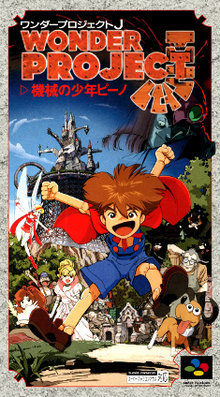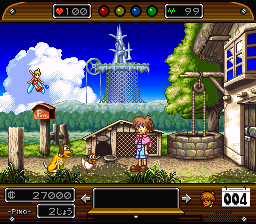1994 video game 1994 video game
| Wonder Project J | |
|---|---|
 | |
| Developer(s) | Almanic Corporation |
| Publisher(s) | Enix |
| Director(s) | Takashi Yoneda |
| Producer(s) | Hiroki Fujimoto |
| Designer(s) | Takashi Yoneda |
| Programmer(s) | Hiroko Yamahiko Hiromitsu Shioya Takashi Sorimachi |
| Artist(s) | Toshihiro Kawamoto Umanosuke Iida |
| Writer(s) | Takashi Yoneda |
| Composer(s) | Akihiko Mori |
| Series | Wonder Project J |
| Platform(s) | Super Famicom |
| Release | |
| Genre(s) | Life simulation |
| Mode(s) | Single-player |
Wonder Project J is a 1994 life simulation video game developed by Almanic Corporation and published by Enix for the Super Famicom. In the game, players take care of a boy Gijin (robot) created by Dr. Geppetto named Pino. Directed by Takashi Yoneda, the title was created by most of the same personnel that worked on previous projects at Almanic such as E.V.O.: Search for Eden. It was met with positive reception from critics and sold over 1.3 million copies in Japan, making it one of the best-selling Super Famicom games. A sequel, Wonder Project J2, was released in 1996 for the Nintendo 64.
Gameplay

Wonder Project J is a life simulation game in which the player raises a Pinocchio-esque boy named Pino, who displays a very large amount of animations to make him appear more human to the player. The game uses Pino's fairy companion Tinker as a point and click interface like an adventure game, with the main goal being educate Pino to make him more human, which can be accomplished by scolding him when he does something wrong and praising him when he does something right.
The player collects a variety of items through the adventure. Some are used to train various parameters of his character (strength, kindness, etc.), some are consumables which instantly adjust his various character parameters (giving him pudding will increase his trust, batteries increase his health, etc.), while others are used to teach him certain behaviours (sowing seeds, fighting with a sword, etc.).
Pino needs to succeed in various challenges and confrontations to activate various virtue circuits to finally activate “Circuit J”. These tasks are accomplished based on various parameters of his character (is he strong enough, does he have enough luck, etc.) The purpose of the final circuit is to help with his final task to foster relations between humans and the robot-like Gijin.
Pino has two health bars. One is physical health while the other is mental health. Physical tasks (like climbing up a rope) or getting hurt physically reduces physical health, while mental tasks (like reading a book) or getting feelings hurt reduces mental health. Some tasks may reduce both health bars.
Pino may sleep in order to restore his health in exchange for a small amount of money and the passing of one day. The day counter does not affect the game, except for certain tasks like farming and setting out to sea.
Upon finishing the game, Dr. Geppetto and Tinker encourage the player to play the game again, finishing each act within a certain amount of days, in order to get the secret ending.
Synopsis
| This section needs expansion. You can help by adding to it. (August 2020) |
Development and release
Wonder Project J was developed by Almanic Corporation, which also developed E.V.O.: Search for Eden, in conjunction with Mint and Omnibus Promotion. Takashi Yoneda served as the project's director, as well as designer and writer. Hiroki Fujimoto also served as producer. Yoneda recalled on his personal website that he had a difficult time understanding the concept of communicating with a character via a point and click interface, however he succeeded in realizing the game due to cooperation with late anime director Umanosuke Iida. Yoneda stated he used both Sekai Meisaku Gekijō and works from Toei Animation as models for world building. Yoneda has since regarded the title as "the most thoughtful and deep work" for him. Japanese animator Toshihiro Kawamoto also worked as artist for the game and also illustrated the cover art.
Wonder Project J was first released for the Super Famicom by Enix in Japan on 4 December 1994. An official strategy guide was also released in Japan by Enix. Because the game was never published outside Japan, a fan translation was released in 2001.
Reception
Reception| Publication | Score |
|---|---|
| Famitsu | (SFC) 28/40 |
| PlayStation Magazine (JP) | (SFC) 22.6/30 |
| Super Game Power | (SFC) 4.2/5.0 |
In April 1995, Famitsu's "Reader Cross Review" section gave Wonder Project J a 7 out of 10. The game was a commercial hit, with sales of 1.3 million units in Japan alone. Hardcore Gamer gave the title a positive retrospective outlook. In 2011, 1UP.com's Bob Mackey listed it among the "Six Must-Play Super Nintendo Imports".
Sequel
A sequel, Wonder Project J2, was developed by Givro Corporation (previously Almanic Corp.) and released by Enix for the Nintendo 64 in 1996, serving as one of the last projects by Givro prior to their dissolution in 1998. The sequel was later re-released by Square Enix as a two-part download for mobile phones in Japan in 2010.
Notes
- Additional work by Mint and Omnibus Promotion.
- Known as Wonder Project J: Machine Boy Pino (Japanese: ワンダープロジェクトJ: 機械の少年ピーノ, Hepburn: Wandā Purojeku Jei: Kikai no Shōnen Pīno) in Japan.
References
- ^ Almanic Corporation (9 December 1994). Wonder Project J (Super Famicom) (in Japanese). Enix. Level/area: Staff roll.
- ^ Wonder Project J manual (Super Famicom, JP)
- de Costanzo, Nic; Nicholson, Zy (February 1995). "Super Express: Fantasy Quest - Project J". Super Play. No. 28. Future Publishing. pp. 14–15.
- "Big in Japan: Wonder Project J - Un Pinocho a la japonesa". Hobby Consolas (in Spanish). No. 42. Hobby Press. March 1995. p. 14.
- ^ "Nintendo News: Occhio, Malocchio, Prezzemolo e Pinocchio". Mega Console (in Italian). No. 29. Futura Publishing. September 1996. p. 24.
- ^ Sczepaniak, John (4 May 2017). "Wonder Project J". Hardcore Gaming 101. Archived from the original on 17 August 2020. Retrieved 16 August 2020.
- ^ Yoneda, Takashi (2003). "Hirano Bucho-Do: Cyber Games Profile". Takashi Yoneda Official Website. Archived from the original on 26 March 2003. Retrieved 12 August 2020.
- ^ Ciolek, Todd (6 August 2012). "Falls from Grace: How Four Creative Game Companies Went Astray - Givro: Growing Pains". 1UP.com. IGN. Archived from the original on 2 November 2012. Retrieved 16 August 2020.
- "ワンダープロジェクトJ2 開発者インタビュー". Dengeki Super Famicom (in Japanese). Vol. 3. MediaWorks. 1995. (Translation by Shmuplations. Archived 2020-11-30 at the Wayback Machine).
- ^ Mackey, Bob (19 August 2011). "Six Must-Play Super Nintendo Imports - Check out the best 16-bit games you (probably) never played (Page 2)". 1UP.com. IGN. Archived from the original on 7 June 2016. Retrieved 16 August 2020.
- Brett, Stuart; Jarratt, Steve (5 January 2016). Wonder Project J. Bitmap Books. pp. 1–276. ISBN 978-0993012969.
{{cite book}}:|work=ignored (help) - "ワンダープロジェクトJ~機械の少年ピーノ~" (in Japanese). Square Enix. 2020. Archived from the original on 24 July 2017. Retrieved 16 August 2020.
- ワンダープロジェクトJ―機械の少年ピーノ 公式ガイドブック (in Japanese). Enix. December 1994. pp. 1–143. ISBN 978-4870257863.
- Szczepaniak, John (June 2011). "Import Only: Wonder Project J". Retro Gamer. No. 91. Imagine Publishing. pp. 58–59.
- "NEW GAMES CROSS REVIEW: ワンダープロジェクトJ -機械の少年ピーノ- (SFC)". Famitsu (in Japanese). ASCII Corporation. 1994. Archived from the original on 15 August 2018. Retrieved 16 August 2020.
- 超絶 大技林 '98年春版: スーパーファミコン - ワンダープロジェクトJ 機械の少年ピーノ (Special) (in Japanese). Vol. 42. Tokuma Shoten Intermedia. 15 April 1998. p. 430. ASIN B00J16900U.
{{cite book}}:|work=ignored (help) - Bros, Marjorie (September 1995). "SNES - Wonder Project J". Super Game Power (in Portuguese). No. 18. Nova Cultural. pp. 24–25.
- "読者クロスレビュー: ワンダープロジェクトJ -機械の少年ピーノ-". Famitsu (in Japanese). No. 330. ASCII Corporation. 14 April 1995. p. 31.
- "Features: Played in Japan - The next wave of Far Eastern RPGs (Page 5)". Next Generation. Imagine Media. 1996. Archived from the original on 6 June 1997. Retrieved 16 August 2020.
- "Forgotten - Games America Forgot". Hardcore Gamer. Vol. 5, no. 1. Prima Games. June 2009. p. 61.
- Loe, Casey (February 1997). "Japan Now - Wonder Project J2". GameFan. Vol. 5, no. 2. Metropolis Media. pp. 112–113.
- ^ Sahdev, Ishaan (19 April 2010). "Wonder Project J2 Heading To iPhone". Siliconera. Curse LLC. Archived from the original on 25 September 2016. Retrieved 12 August 2020.
- "『ワンダープロジェクトJ2 コルロの森のジョゼット』がiモードで配信開始". Famitsu (in Japanese). Enterbrain. 12 April 2010. Archived from the original on 14 June 2010. Retrieved 12 August 2020.
- Nakano, Shinji (12 April 2010). "スクエニ、iモード「ワンダープロジェクトJ2 コルロの森のジョゼット」 - 携帯電話版オリジナルの会話シーンやイラストを収録して登場". GAME Watch (in Japanese). Impress Corporation. Archived from the original on 6 August 2017. Retrieved 12 August 2020.
External links
| Givro Corporation | |
|---|---|
| Games | |
| People | |
- 1994 video games
- Enix games
- Givro Corporation games
- Japan-exclusive video games
- Raising sims
- Single-player video games
- Square Enix franchises
- Super Nintendo Entertainment System games
- Super Nintendo Entertainment System-only games
- Video games about robots
- Video games developed in Japan
- Video games featuring non-playable protagonists
- Video games scored by Akihiko Mori